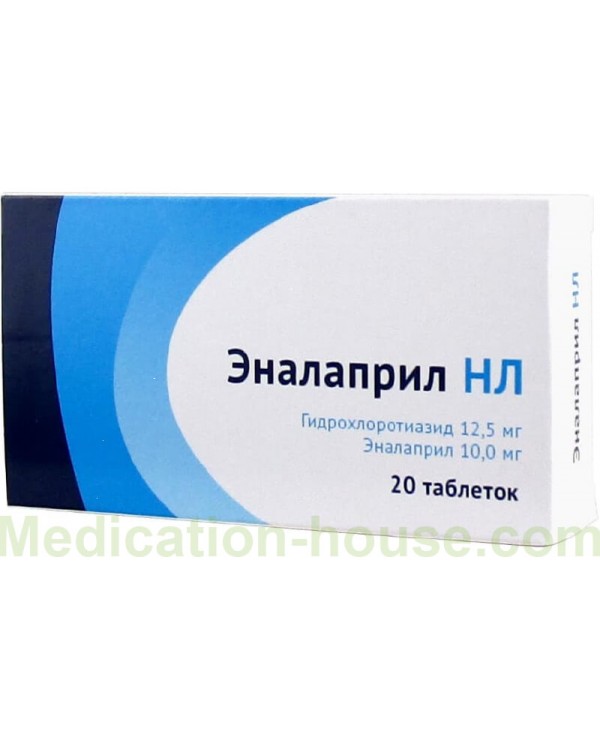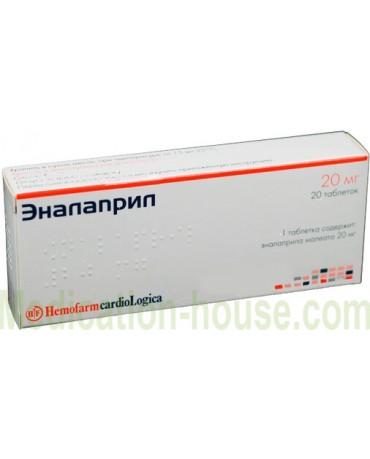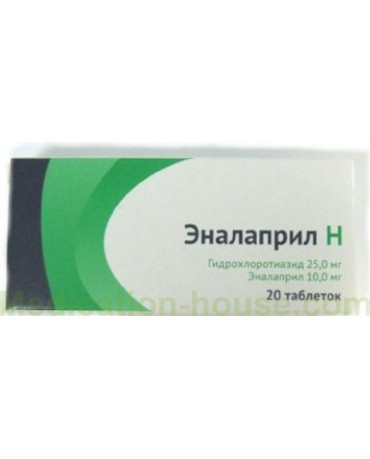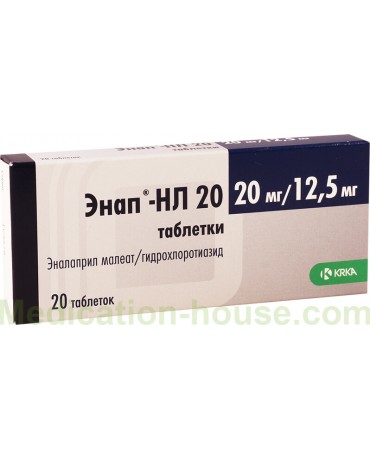Enalapril HL instruction
You can buy Enalapril HL on this page
Release form, composition and packaging
There are 10 dragees in one plate. The active ingredients of Enalapril HL 20 are substances called hydrochlorothiazide and enalapril maleate. Their dosage in one pill is 12.5 and 20 milligrams, respectively. The auxiliary composition of the drug is represented by lactose monohydrate, MCC, povidone, croscarmellose sodium, silica and E572. The price of Enalapril HL is low and affordable. Reviews about Enalapril HL are positive. In them, patients note the good tolerance and effectiveness of the drug. It gently lowers and stabilizes blood pressure levels. Due to the diuretic action, it eliminates puffiness.
Pharmachologic effect
The drug has a combined composition. Hydrochlorothiazide is considered a diuretic that belongs to the thiazide group. It is the level of sodium in the vascular walls, due to which their walls expand. The second component, enalapril, slows down the reaction of the angiotensin-converting enzyme, which converts angiotensin I to II. It is this hormone that narrows blood vessels and arteries, which increases the level of blood pressure. You can order Enalapril HL with delivery in Moscow or other cities of Russia in our online pharmacy. Wer.ru guarantees first-class fast service as well as low and favorable prices.
Indications
The instructions provided by the manufacturer indicate that the medicine should be prescribed to patients suffering from: - hypertension; - severe heart pathologies in a chronic form.
Contraindications
Refuse therapy with Enalapril and analogues should be in the presence of such indications: - lack of urine flow into the bladder; - severe renal dysfunction, in which creatinine clearance does not exceed 30 milliliters in 1 minute; - a predisposition to the development of Quincke's edema (including when taking drugs that slow down the reaction of the angiotensin-converting enzyme); - narrowing of the lumen of the arteries of both kidneys; - the structure of the artery of a single kidney; - the period of bearing the child and his subsequent breastfeeding; - insufficient age (less than 18 years old); - excessive susceptibility of the constituents of the drug; - lactose intolerance. The following features and diseases are not contraindications, but require precautions during treatment: - aortic stenosis; - hypertrophy of the left side of the interventricular septum and left ventricle, which impedes the outflow of blood from the left ventricle to the aorta; - ischemia; - pathology of cerebral vessels, disrupting cerebral circulation; - chronic heart dysfunction; - pronounced atherosclerotic vascular lesions; - serious autoimmune pathologies affecting connective tissues; - oppressed hematopoiesis of the bone marrow; - diabetes mellitus; - an increased level of potassium in the blood; - postponed renal transplant; - moderate failures in the functioning of the kidneys and liver; - reduced volume of circulating blood; - old age.
Method of administration and dosage
Enalapril HL is intended for oral administration. You can take it at any time, both before and after eating. Do not chew the tablets, but drink them whole in the amount of 1-2 pieces at a time. Patients suffering from moderate disorders in the functioning of the kidneys are shown a careful selection of the dosage regimen, in which the volume of the drug taken does not exceed 5-10 milligrams per day.
Side effects
Usually, therapy with this drug is well tolerated by patients. Nevertheless, manufacturers are known to have cases when the use provoked a feeling of loss of equilibrium, excessive weakness, urge to vomit, a sharp decrease in blood pressure when changing the horizontal position of the body to the vertical one. Sometimes the treatment caused cephalalgia, sexual dysfunction, fainting, increased heart rate, pain in the chest, muscle twitching, coughing fits, and numbness in the limbs. Some patients developed allergic symptoms, in particular Quincke's edema, anaphylaxis, various cutaneous erythema and dermatitis. The possibility of sleep dysfunction, the appearance of excessive nervous excitability, shortness of breath, dryness in the oral cavity, indigestion, loose stools, or, conversely, difficult defecation, increased gas production, inflammation of the pancreas and pain in the epigastric region is not excluded. Occasionally, taking pills led to malfunctions of the kidneys, increased sweating, changes in laboratory parameters, in particular to an increase in the level of sugar, uric acid, creatinine, potassium, bilirubin, leukocytes in the blood. The use can also provoke an exacerbation or development of gout, pain in the joints, bones and muscles, tinnitus, increased sensitivity to sunlight and lupus-like symptoms.
Overdose
Taking the drug at a dosage significantly higher than the norm can lead to a significant decrease in blood pressure, which, in turn, provokes a heart attack, impaired cerebral circulation (stroke) and cardiac arrest. Also, in a similar situation, a depressed mental state with lethargy and inactivity, as well as convulsive contractions of the limbs or individual parts of the body, may occur. If a little time has passed since the reception, then the patient should thoroughly rinse the stomach and drink a saline solution. Also shown is the intravenous infusion of plasma-substituting solutions, drugs that accelerate the enzymatic reaction of angiotensin II and blood purification using the "artificial kidney" apparatus.
Drug interactions
Potassium-containing drugs and supplements, as well as salt substitutes, when combined with this medication (especially in patients suffering from kidney failure), usually lead to an increase in the level of potassium in the blood. Enalapril prevents the elimination of potassium from the body, provoked by the intake of diuretics. Due to its action, the concentration of potassium often does not change and is at a normal level. Lithium-containing drugs, when interacting with a combination of enalapril and hydrochlorothiazide, slow down the process of excretion of this trace element from the body, which increases the toxic effect on the central and peripheral nervous system, as well as on the heart. When combining diuretics of the thiazide group with tubocurarine chloride, the effect of the latter is enhanced. Analgesics of the opioid group, when combined with diuretics, can provoke a sharp decrease in the level of blood pressure when changing from a horizontal position to a vertical one. The same consequences are observed when combining this drug with phenothiazine and its derivatives. Combined therapy of enalapril with beta- and alpha-adrenoreceptor blockers leads to a significant decrease in blood pressure. When enalapril is combined with n-anticholinergics that act on nicotine-sensitive receptors located in the autonomic ganglia, an excessive drop in blood pressure occurs. Methyldopa and calcium antagonists, when interacting with enalapril, provoke the development of hypotension. Allopurinol, anticancer drugs, in particular cytostatics, as well as agents that suppress immunity, when combined with angiotensin-converting enzyme inhibitors, increase the risk of an excessive decrease in the level of leukocytes in the blood. Glucocorticoids and calcitonin, when interacting with diuretics of the thiazide group, provoke an excessive decrease in the level of potassium in the blood. Combined therapy with cyclosporine and enalapril can lead to a significant increase in the concentration of potassium in the blood. Taking non-steroidal anti-inflammatory drugs, for example, drugs that selectively slow down the reaction of cyclooxygenase-2, can reduce the effectiveness of the drug described in the instructions. This combination can also increase the level of potassium in the blood, which provokes renal dysfunction, especially in patients suffering from disorders in the functioning of this organ. Taking antacids together with enalapril and hydrochlorothiazide reduces the absorption of the latter. Drugs that stimulate the functioning of the sympathetic part of the nervous system reduce the effectiveness of enalapril. When combined with adronomimetics, in particular epinephrine, the diuretic effect of the drug considered in the description is minimized. The combined intake of alcoholic beverages with this antihypertensive drug causes a sharp decrease in the level of pressure when the horizontal position of the body changes to the vertical one. Studies have shown that angiotensin-converting enzyme inhibitors, when combined with antidiabetic agents, can lead to a significant decrease in blood glucose levels. A similar condition often occurs at the beginning of therapy in patients with impaired renal function. Patients suffering from diabetes mellitus and taking this remedy are shown regular monitoring of blood counts. The use of hydrochlorothiazide with insulin and antidiabetic drugs does not exclude the need to correct the dosage regimen. Cholestyramine and colestipol when combined with hydrochlorothiazide lead to a decrease in the effectiveness of the latter. Taking sodium auropiomalate with medicines that slow down the reaction of the angiotensin-converting enzyme can lead to flushing of the face, the urge to vomit and vomiting itself, as well as an excessive decrease in blood pressure.
Special instructions
During the period of therapy with a combination of enalapril and hydrochlorothiazide, patients are shown regular monitoring of kidney function, blood pressure and potassium levels in the blood. At the beginning of the course of treatment with this drug, it is possible to develop negative symptoms that affect the degree of concentration, therefore, it is better to refuse driving and working with responsible equipment and machines.
Terms and conditions of storage
Keep blisters with tablets out of the reach of children and sunlight. Store at a temperature not exceeding +25 ° C.
Terms of sell
You don't need a doctor's prescription to buy Enalapril HL.




